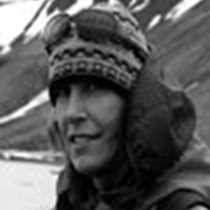Saginaw Bay and Basket Bay, AK
Today the shores and cliffs of Saginaw Bay spoke volumes about the history lived out on its shores. We landed our Zodiacs at high tide at the base of limestone cliffs upthrust from the sea floor some 250-300 million years ago and bearing to this day traces of the marine life of that time. In this case, fossils of brachiopods (pictured at right), ancient bivalves similar to the clams actively siphoning the sea water at our backs. Kayakers paddled beneath red pictographs made by people who have used this land for millennia before Muir’s first wonder. Although Alaska is new and raw and at times, can still convey the sense of just-made wilderness, such reminders of this land’s history are a welcome connection to the larger movements of our planet, reminding us that Alaska is not entirely apart from the lives we left in coming here.
As the tide went out, more evidence of life was revealed. Black bear, mink, Sitka black-tailed deer, and wolf (pictured at left) impressed their weight into the sand they traveled within the last day. We followed their paths until they were lost in the rocks, happy to be reminded that even though our binoculars are trained and our gazes keen, there are comings and goings that pass beyond our notice.
Jason Kelley, our Expedition Leader and a geologist by training, pointed out a unique example of xenoliths—literally “foreign rocks”—embedded within a hunk of granite. And later, in Basket Bay, we took Zodiacs deep into a marble grotto excavated by water. Spruce and hemlock towered above and a river flowed under the natural stone bridge, filtering the early evening sun.
Altogether, the day proved what is most difficult to discover: that every aspect of what we see has a story to reveal, if only we can learn how to best look and listen so that it can be revealed.
Today the shores and cliffs of Saginaw Bay spoke volumes about the history lived out on its shores. We landed our Zodiacs at high tide at the base of limestone cliffs upthrust from the sea floor some 250-300 million years ago and bearing to this day traces of the marine life of that time. In this case, fossils of brachiopods (pictured at right), ancient bivalves similar to the clams actively siphoning the sea water at our backs. Kayakers paddled beneath red pictographs made by people who have used this land for millennia before Muir’s first wonder. Although Alaska is new and raw and at times, can still convey the sense of just-made wilderness, such reminders of this land’s history are a welcome connection to the larger movements of our planet, reminding us that Alaska is not entirely apart from the lives we left in coming here.
As the tide went out, more evidence of life was revealed. Black bear, mink, Sitka black-tailed deer, and wolf (pictured at left) impressed their weight into the sand they traveled within the last day. We followed their paths until they were lost in the rocks, happy to be reminded that even though our binoculars are trained and our gazes keen, there are comings and goings that pass beyond our notice.
Jason Kelley, our Expedition Leader and a geologist by training, pointed out a unique example of xenoliths—literally “foreign rocks”—embedded within a hunk of granite. And later, in Basket Bay, we took Zodiacs deep into a marble grotto excavated by water. Spruce and hemlock towered above and a river flowed under the natural stone bridge, filtering the early evening sun.
Altogether, the day proved what is most difficult to discover: that every aspect of what we see has a story to reveal, if only we can learn how to best look and listen so that it can be revealed.




